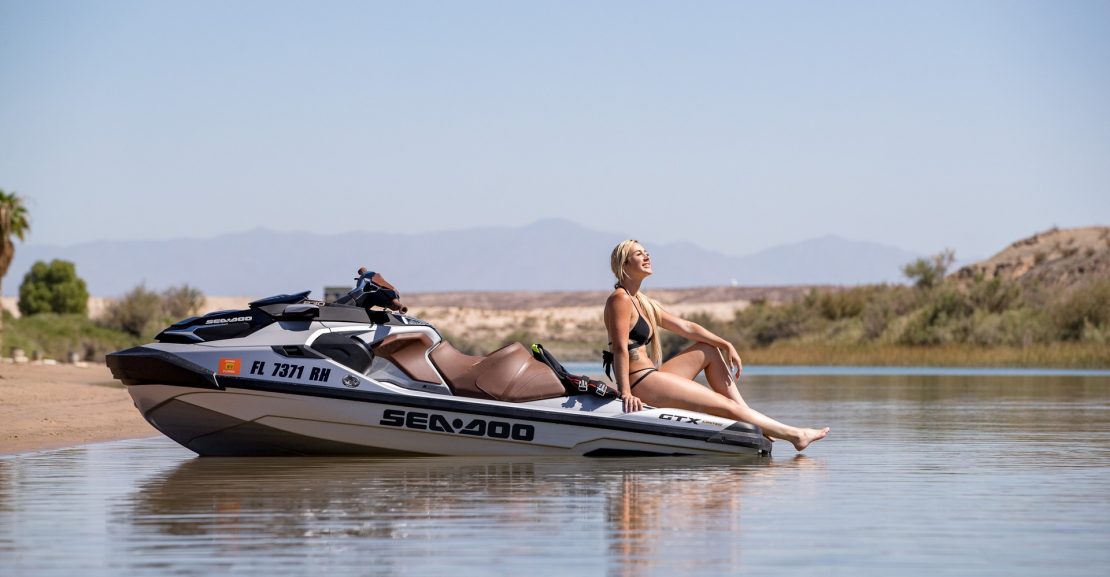Fifty years ago, Bombardier made the leap into a new field by marketing its first Sea-Doo personal watercraft. The model was produced from 1968 to 1969, but sales were halted due to design problems, as the engines, which were air-cooled at the time, tended to overheat—and even explode.
Come 1988, the manufacturer decided the time was ripe for a comeback and they’ve never looked back. Nostalgic readers will remember the XP models whose first generation was introduced in 1992. The Sea-Doo XP 94 was memorable, as was the 1995 XP 800. With 110 horsepower, it was quite the speed demon back then.
Prolong the honeymoon
2014 saw a return to more affordable models with the Spark, and now Sea-Doo wants to dispel the myth that a personal watercraft is only good for short rides. The stated goal is to ensure that buyers discover new possibilities thanks to a glut of new functions. Basically, they want to extend the honeymoon for owners.
To do this, the GTX, RXT and Wake three-seaters have been literally transformed into more practical and user-friendly touring models. The crux of this change is a new platform that lets you modulate the rear platform for sunbathing or swimming. An ingenious anchoring system has also been added to help you transport three new accessories: a 15-litre (4-gallon) gas tank, cooler and storage bag. This equipment lets you push the limits of what you can do with a personal watercraft while benefiting from some of the advantages of a traditional boat. Why not even go on a trip for a few days?
The other significant change is the increased-capacity, easier-access storage compartment. The cover is now comprised of the entire handlebar section, and once it’s in place, the driver can easily access it while remaining seated. That means it’s no longer necessary go over the handlebars. This year, it features 100 litres of cargo capacity, which is almost enough to fit a small dry bag.
A sound system
To make rides more pleasant, the engineers integrated a 100-watt sound system – optional on certain models – that includes two speakers located on either side of the craft. Just link up your smart phone via Bluetooth and then put it in the new watertight phone box. In a few seconds, you’ll be listening to the music of your choice in surprisingly good sound quality. The volume is sufficient, as the speakers are oriented towards you. Imagine riding your Sea-Doo while jamming to your favourite tunes against such beautiful backdrops. Even when the craft is stopped, the system remains operational, but it will never drain your battery completely. When we least expected it, it won us over!
More control and stability
Despite appearances, the new platform for the three-seat models is short but a tad wider than in the past. You can easily go anywhere without worrying about capsizing.On the water, three-seaters aren’t as dynamic or as manoeuvrable as two-seaters, but a few little tweaks helped turn the fun up a notch. The seat has been lowered a few centimetres to bring the centre of gravity down, making you feel a bit more connected to the water and more confident – especially in rough waters. They managed, however, to preserve the driving position by reducing the height of the running boards.They also took the opportunity to reduce the engine weight by 86 to 90 pounds (depending on the model) by enhancing the efficiency of the riding plate, which cools the oil more efficiently, thereby allowing the elimination of the intercooler.
The GTX, Wake and RXT versions are definitely bigger and less easy to handle than the more compact two-seaters, but on longer trips and in rougher waters, you’ll appreciate their superior comfort. Opt for the versions equipped with 260- or even 300-horsepower engines and you’ll get a watercraft that will introduce you to muscles you didn’t know you had—at least on your first few rides.
As fans of sportier, more compact models, we were never really interested in three-passenger versions, but BRP has succeeded in adding several features that are sure to make believers out of more than a few people.
Could these more compact, two-seaters inherit some of these changes in the near future, too? It’s a safe bet that if the three-seaters are successful, these innovations could very well find their way into the more compact watercrafts as well.

